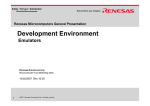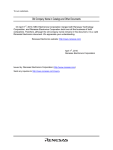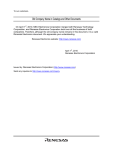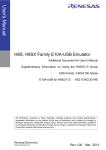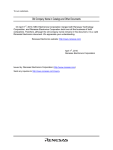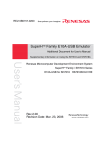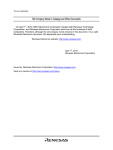Download H8S, H8SX Family E10A-USB Emulator Additional Document for
Transcript
To our customers, Old Company Name in Catalogs and Other Documents On April 1st, 2010, NEC Electronics Corporation merged with Renesas Technology Corporation, and Renesas Electronics Corporation took over all the business of both companies. Therefore, although the old company name remains in this document, it is a valid Renesas Electronics document. We appreciate your understanding. Renesas Electronics website: http://www.renesas.com April 1st, 2010 Renesas Electronics Corporation Issued by: Renesas Electronics Corporation (http://www.renesas.com) Send any inquiries to http://www.renesas.com/inquiry. Notice 1. 2. 3. 4. 5. 6. 7. All information included in this document is current as of the date this document is issued. Such information, however, is subject to change without any prior notice. Before purchasing or using any Renesas Electronics products listed herein, please confirm the latest product information with a Renesas Electronics sales office. Also, please pay regular and careful attention to additional and different information to be disclosed by Renesas Electronics such as that disclosed through our website. Renesas Electronics does not assume any liability for infringement of patents, copyrights, or other intellectual property rights of third parties by or arising from the use of Renesas Electronics products or technical information described in this document. No license, express, implied or otherwise, is granted hereby under any patents, copyrights or other intellectual property rights of Renesas Electronics or others. You should not alter, modify, copy, or otherwise misappropriate any Renesas Electronics product, whether in whole or in part. Descriptions of circuits, software and other related information in this document are provided only to illustrate the operation of semiconductor products and application examples. You are fully responsible for the incorporation of these circuits, software, and information in the design of your equipment. Renesas Electronics assumes no responsibility for any losses incurred by you or third parties arising from the use of these circuits, software, or information. When exporting the products or technology described in this document, you should comply with the applicable export control laws and regulations and follow the procedures required by such laws and regulations. You should not use Renesas Electronics products or the technology described in this document for any purpose relating to military applications or use by the military, including but not limited to the development of weapons of mass destruction. Renesas Electronics products and technology may not be used for or incorporated into any products or systems whose manufacture, use, or sale is prohibited under any applicable domestic or foreign laws or regulations. Renesas Electronics has used reasonable care in preparing the information included in this document, but Renesas Electronics does not warrant that such information is error free. Renesas Electronics assumes no liability whatsoever for any damages incurred by you resulting from errors in or omissions from the information included herein. Renesas Electronics products are classified according to the following three quality grades: “Standard”, “High Quality”, and “Specific”. The recommended applications for each Renesas Electronics product depends on the product’s quality grade, as indicated below. You must check the quality grade of each Renesas Electronics product before using it in a particular application. You may not use any Renesas Electronics product for any application categorized as “Specific” without the prior written consent of Renesas Electronics. Further, you may not use any Renesas Electronics product for any application for which it is not intended without the prior written consent of Renesas Electronics. Renesas Electronics shall not be in any way liable for any damages or losses incurred by you or third parties arising from the use of any Renesas Electronics product for an application categorized as “Specific” or for which the product is not intended where you have failed to obtain the prior written consent of Renesas Electronics. The quality grade of each Renesas Electronics product is “Standard” unless otherwise expressly specified in a Renesas Electronics data sheets or data books, etc. “Standard”: 8. 9. 10. 11. 12. Computers; office equipment; communications equipment; test and measurement equipment; audio and visual equipment; home electronic appliances; machine tools; personal electronic equipment; and industrial robots. “High Quality”: Transportation equipment (automobiles, trains, ships, etc.); traffic control systems; anti-disaster systems; anticrime systems; safety equipment; and medical equipment not specifically designed for life support. “Specific”: Aircraft; aerospace equipment; submersible repeaters; nuclear reactor control systems; medical equipment or systems for life support (e.g. artificial life support devices or systems), surgical implantations, or healthcare intervention (e.g. excision, etc.), and any other applications or purposes that pose a direct threat to human life. You should use the Renesas Electronics products described in this document within the range specified by Renesas Electronics, especially with respect to the maximum rating, operating supply voltage range, movement power voltage range, heat radiation characteristics, installation and other product characteristics. Renesas Electronics shall have no liability for malfunctions or damages arising out of the use of Renesas Electronics products beyond such specified ranges. Although Renesas Electronics endeavors to improve the quality and reliability of its products, semiconductor products have specific characteristics such as the occurrence of failure at a certain rate and malfunctions under certain use conditions. Further, Renesas Electronics products are not subject to radiation resistance design. Please be sure to implement safety measures to guard them against the possibility of physical injury, and injury or damage caused by fire in the event of the failure of a Renesas Electronics product, such as safety design for hardware and software including but not limited to redundancy, fire control and malfunction prevention, appropriate treatment for aging degradation or any other appropriate measures. Because the evaluation of microcomputer software alone is very difficult, please evaluate the safety of the final products or system manufactured by you. Please contact a Renesas Electronics sales office for details as to environmental matters such as the environmental compatibility of each Renesas Electronics product. Please use Renesas Electronics products in compliance with all applicable laws and regulations that regulate the inclusion or use of controlled substances, including without limitation, the EU RoHS Directive. Renesas Electronics assumes no liability for damages or losses occurring as a result of your noncompliance with applicable laws and regulations. This document may not be reproduced or duplicated, in any form, in whole or in part, without prior written consent of Renesas Electronics. Please contact a Renesas Electronics sales office if you have any questions regarding the information contained in this document or Renesas Electronics products, or if you have any other inquiries. (Note 1) “Renesas Electronics” as used in this document means Renesas Electronics Corporation and also includes its majorityowned subsidiaries. (Note 2) “Renesas Electronics product(s)” means any product developed or manufactured by or for Renesas Electronics. H8S, H8SX Family E10A-USB Emulator Additional Document for User's Manual Supplementary Information on Using the H8S_custom_SoC Renesas Microcomputer Development Environment System H8S Family E10A-USB for H8S_custom_SoC HS2000KCU01HE Rev.6.00 2010.03 Rev. 6.00 Mar. 03, 2010 Page ii of viii REJ10J1151-0600 Notes regarding these materials 1. This document is provided for reference purposes only so that Renesas customers may select the appropriate Renesas products for their use. Renesas neither makes warranties or representations with respect to the accuracy or completeness of the information contained in this document nor grants any license to any intellectual property rights or any other rights of Renesas or any third party with respect to the information in this document. 2. Renesas shall have no liability for damages or infringement of any intellectual property or other rights arising out of the use of any information in this document, including, but not limited to, product data, diagrams, charts, programs, algorithms, and application circuit examples. 3. You should not use the products or the technology described in this document for the purpose of military applications such as the development of weapons of mass destruction or for the purpose of any other military use. When exporting the products or technology described herein, you should follow the applicable export control laws and regulations, and procedures required by such laws and regulations. 4. All information included in this document such as product data, diagrams, charts, programs, algorithms, and application circuit examples, is current as of the date this document is issued. Such information, however, is subject to change without any prior notice. Before purchasing or using any Renesas products listed in this document, please confirm the latest product information with a Renesas sales office. Also, please pay regular and careful attention to additional and different information to be disclosed by Renesas such as that disclosed through our website. (http://www.renesas.com ) 5. Renesas has used reasonable care in compiling the information included in this document, but Renesas assumes no liability whatsoever for any damages incurred as a result of errors or omissions in the information included in this document. 6. When using or otherwise relying on the information in this document, you should evaluate the information in light of the total system before deciding about the applicability of such information to the intended application. Renesas makes no representations, warranties or guaranties regarding the suitability of its products for any particular application and specifically disclaims any liability arising out of the application and use of the information in this document or Renesas products. 7. With the exception of products specified by Renesas as suitable for automobile applications, Renesas products are not designed, manufactured or tested for applications or otherwise in systems the failure or malfunction of which may cause a direct threat to human life or create a risk of human injury or which require especially high quality and reliability such as safety systems, or equipment or systems for transportation and traffic, healthcare, combustion control, aerospace and aeronautics, nuclear power, or undersea communication transmission. If you are considering the use of our products for such purposes, please contact a Renesas sales office beforehand. Renesas shall have no liability for damages arising out of the uses set forth above. 8. Notwithstanding the preceding paragraph, you should not use Renesas products for the purposes listed below: (1) artificial life support devices or systems (2) surgical implantations (3) healthcare intervention (e.g., excision, administration of medication, etc.) (4) any other purposes that pose a direct threat to human life Renesas shall have no liability for damages arising out of the uses set forth in the above and purchasers who elect to use Renesas products in any of the foregoing applications shall indemnify and hold harmless Renesas Technology Corp., its affiliated companies and their officers, directors, and employees against any and all damages arising out of such applications. 9. You should use the products described herein within the range specified by Renesas, especially with respect to the maximum rating, operating supply voltage range, movement power voltage range, heat radiation characteristics, installation and other product characteristics. Renesas shall have no liability for malfunctions or damages arising out of the use of Renesas products beyond such specified ranges. 10. Although Renesas endeavors to improve the quality and reliability of its products, IC products have specific characteristics such as the occurrence of failure at a certain rate and malfunctions under certain use conditions. Please be sure to implement safety measures to guard against the possibility of physical injury, and injury or damage caused by fire in the event of the failure of a Renesas product, such as safety design for hardware and software including but not limited to redundancy, fire control and malfunction prevention, appropriate treatment for aging degradation or any other applicable measures. Among others, since the evaluation of microcomputer software alone is very difficult, please evaluate the safety of the final products or system manufactured by you. 11. In case Renesas products listed in this document are detached from the products to which the Renesas products are attached or affixed, the risk of accident such as swallowing by infants and small children is very high. You should implement safety measures so that Renesas products may not be easily detached from your products. Renesas shall have no liability for damages arising out of such detachment. 12. This document may not be reproduced or duplicated, in any form, in whole or in part, without prior written approval from Renesas. 13. Please contact a Renesas sales office if you have any questions regarding the information contained in this document, Renesas semiconductor products, or if you have any other inquiries. Rev. 6.00 Mar. 03, 2010 Page iii of viii REJ10J1151-0600 Rev. 6.00 Mar. 03, 2010 Page iv of viii REJ10J1151-0600 Regulatory Compliance Notices European Union Regulatory Notices on Electromagnetic Compatibility CE Certifications: This product complies with the following European EMC standards. • EMC Directive 2004/108/EC EN 55022 Class A WARNING: This is a Class A product. In a domestic environment this product may cause radio interference in which case the user may be required to take adequate measures. EN 55024 Information for Traceability: • Authorized representative Name: Renesas Technology Corp. Address: Nippon Bldg., 2-6-2, Ote-machi, Chiyoda-ku, Tokyo 100-0004, Japan • Manufacturer Name: Renesas Solutions Corp. Address: Nippon Bldg., 2-6-2, Ote-machi, Chiyoda-ku, Tokyo 100-0004, Japan • Person responsible for placing on the market Name: Renesas Technology Europe Limited European Headquarters Address: Dukes Meadow, Millboard Road, Bourne End, Buckinghamshire, SL8 5FH, U.K. Rev. 6.00 Mar. 03, 2010 Page v of viii REJ10J1151-0600 United States Regulatory Notices on Electromagnetic Compatibility FCC Certifications: This equipment has been tested and found to comply with the limits for a Class A digital device, pursuant to Part 15 of the FCC Rules. These limits are designed to provide reasonable protection against harmful interference when the equipment is operated in a commercial environment. This equipment generates, uses, and can radiate radio frequency energy and, if not installed and used in accordance with the instruction manual, may cause harmful interference to radio communications. Operation of this equipment in a residential area is likely to cause harmful interference in which case the user will be required to correct the interference at his own expense. This device complies with Part 15 of the FCC Rules. Operation is subject to the following two conditions: (1) this device may not cause harmful interference, and (2) this device must accept any interference received, including interference that may cause undesired operation. CAUTION: Changes or modifications not expressly approved by the party responsible for compliance could void the user's authority to operate the equipment. Rev. 6.00 Mar. 03, 2010 Page vi of viii REJ10J1151-0600 Contents Section 1 Connecting the Emulator with the User System ................................1 1.1 1.2 1.3 1.4 Components of the E10A-USB Emulator ......................................................................... 1 Connecting the E10A-USB Emulator with the User System ............................................ 2 Pin Assignments of the E10A-USB Connector................................................................. 4 Example of Emulator Connection..................................................................................... 5 Section 2 Specification of the Emulator’s Software ..........................................9 2.1 2.2 Differences between the MCU and the Emulator ............................................................. 9 The H8S custom SoC E10A-USB Emulator Specific Functions and Notes ..................... 10 2.2.1 Emulator Driver Selection ................................................................................... 10 2.2.2 Hardware Break Functions .................................................................................. 11 2.2.3 ROM Correction Function ................................................................................... 12 2.2.4 Notes on Setting the [Breakpoint] Dialog Box .................................................... 13 2.2.5 Note on Using the JTAG Clock (TCK) ............................................................... 13 2.2.6 Trace Function ..................................................................................................... 14 2.2.7 Debugging in the External Flash Memory ........................................................... 15 2.2.8 Interface with Initialization, Write, and Erase Modules and Emulator Firmware .............................................................................................. 19 2.2.9 Tutorial ................................................................................................................ 20 Rev. 6.00 Mar. 03, 2010 Page vii of viii REJ10J1151-0600 Rev. 6.00 Mar. 03, 2010 Page viii of viii REJ10J1151-0600 Section 1 Connecting the Emulator with the User System Section 1 Connecting the Emulator with the User System 1.1 Components of the E10A-USB Emulator The E10A-USB emulator supports SoCs (systems on chips) that incorporate the H8S processor core (these are hereafter collectively referred to as MCUs unless the description is specific to a particular device). Table 1.1 lists the components of the E10A-USB emulator. Table 1.1 Components of the Emulator Classification Component Hardware Emulator box Appearance Quantity 1 Remarks HS0005KCU01H: Depth: 65.0 mm, Width: 97.0 mm, Height: 20.0 mm, Mass: 72.9 g or HS0005KCU02H: Depth: 65.0 mm, Width: 97.0 mm, Height: 20.0 mm, Mass: 73.7 g Software User system interface cable 1 14-pin type: Length: 20 cm, Mass: 33.1 g USB cable 1 Length: 150 cm, Mass: 50.6 g E10A-USB emulator setup program, H8S, H8SX Family E10A-USB Emulator User’s Manual, Supplementary Information on Using the * H8S_custom_SoC , and Test program manual for HS0005KCU01H and HS0005KCU02H 1 HS0005KCU01SR, HS0005KCU01HJ-H8S, HS0005KCU01HE-H8S, HS2000KCU01HJ, HS2000KCU01HE, HS0005TM01HJ, and HS0005TM01HE (provided on a CD-R) Note: Additional document for the MCUs supported by the emulator is included. Check the target MCU and refer to its additional document. Rev. 6.00 Mar. 03, 2010 Page 1 of 20 REJ10J1151-0600 Section 1 Connecting the Emulator with the User System 1.2 Connecting the E10A-USB Emulator with the User System Before connecting an E10A-USB emulator (hereafter referred to as the emulator) with the user system, a connector must be installed in the user system so that a user system interface cable can be connected. When designing the user system, refer to the connector and recommended circuits shown in this manual. Before designing the user system, be sure to read the E10A-USB emulator user’s manual and the hardware manual for related MCUs. Connection between the user system connector and the MCU in each device differs depending on the internal circuit of MCU in use. Examples are shown below, however, for pull up, pull down, and required logic ICs, contact Renesas Technology Corp. via the sales office. Connect pins 8, 9, 10, 12, 13, and 14 of the user system connector to GND firmly on the PCB. These pins are used as electrical GND and to monitor the connection of the user system connector. Note the pin assignments of the user system connector. User system interface cable Tab GND line User system connector Pin 8 User system GND connection Pin 1 User system Figure 1.1 Connecting the User System Interface Cable to the User System Notes: 1. The pin number assignments of the 14-pin connector differ from those of the E8a emulator; however, the physical location is the same. 2. Do not place any components within 3 mm of the connector. Rev. 6.00 Mar. 03, 2010 Page 2 of 20 REJ10J1151-0600 Section 1 Connecting the Emulator with the User System WARNING Be sure to place the GND line of the user system interface cable on the GND of the user system with a screw, etc. Failure to do so will result in a FIRE HAZARD due to an overcurrent and will damage the user system, the emulator product, and the host computer. Rev. 6.00 Mar. 03, 2010 Page 3 of 20 REJ10J1151-0600 Section 1 Connecting the Emulator with the User System 1.3 Pin Assignments of the E10A-USB Connector Figure 1.2 shows the pin assignments of the user system connector. Pin No. Pin 1 mark User system connector Pin 14 Pin 7 Pin 8 Pin 1 MCU Pin Name Input/Output *2 1 TCK Input 2 TRST# Input 3 TDO Output 4 RES(in)# *3 *6 Input 5 TMS Input 6 TDI Input 7 RES(out)# *3 Output 8 to 10 GND *4 12 to 14 11 Vcc *5 Top view Notes: 1. The signal names are based on the names of standard H8S microcomputer pins. For pin names and examples of recommended circuits of the MCU in use, contact Renesas Technology Corp. via the sales office. 2. Input to or output from the user system. 3. The symbol (#) means that the signal is active-low. 4. By detecting GND on the user system, the emulator decides whether the user system is connected or not. 5. Connect Vcc with the Vcc of the MCU. 6. RES(in) is not the pin name of the MCU. It cannot be directly connected to the MCU pins. Pin 1 mark Figure 1.2 Pin Assignments of the User System Connector Rev. 6.00 Mar. 03, 2010 Page 4 of 20 REJ10J1151-0600 Section 1 Connecting the Emulator with the User System 1.4 Example of Emulator Connection The figure shown below is an example of connecting the user system to the emulator. 14-pin connector with a 2.54-mm pitch (3M Limited: 2514-6002) Pulled up at 4.7 kΩ Vcc MCU 11 EMLE 1 TCK 2 TRST# 3 TDO 5 TMS 6 TDI 4 * User logic Peripheral IC controlled by MCU 7 RES# 8 to 10 12 to 14 E10A-USB pin no. User system · RES(in)# of pin 4 of the user system connector is a signal line in which the emulator outputs signals to the MCU. RES(in)# (pin 4) and the user logic reset circuit for the signal line must be connected to the MCU as shown above. · RES(out)# of pin 7 of the user system connector is a signal line in which the emulator monitors the RES# signal of the MCU. The RES# must be pulled up before it is connected to pin 7 of the user system connector. · When a reset processing is required for a peripheral IC controlled by the MCU at a reset of the H8S CPU, also connect the RES# to the peripheral IC indicated by * in the figure. Figure 1.3 Example of Emulator Connection Rev. 6.00 Mar. 03, 2010 Page 5 of 20 REJ10J1151-0600 Section 1 Connecting the Emulator with the User System Notes: 1. Pins TRST#, TCK, TMS, TDO, and TDI are used by the emulator. Pull up and connect the emulator and the MCU pins. MCU User system connector Vcc 4.7 kΩ Pins 1, 2, 3, 5, and 6 Figure 1.4 Connection of Emulator and MCU 2. If the emulator is connected to the user system, pull up pin EMLE of the MCU, and when the emulator is not connected to the user system, ground the EMLE. MCU Vcc The emulator is connected to the user system. 4.7 k EMLE MCU The emulator is not connected to the user system. EMLE Figure 1.5 Emulator and Pin EMLE Rev. 6.00 Mar. 03, 2010 Page 6 of 20 REJ10J1151-0600 Section 1 Connecting the Emulator with the User System 3. RES(in)# of pin 4 of the user system connector is a signal line in which the emulator outputs signals to the MCU. RES(in)# of pin 4 and the user logic reset circuit for the signal line must be connected to pin RES# of the MCU as shown in figure 1.6. RES(out)# of pin 7 of the user system connector is a signal line in which the emulator monitors pin RES# of the MCU. The RES# must be pulled up before it is connected to pin 7 of the user system connector. When a reset processing is required for a peripheral IC controlled by the MCU at a reset of the H8S CPU, also connect the RES# to the peripheral IC indicated by * in the figure. Vcc 4.7 kΩ User system connector RES(in)# (pin 4) Reset circuit MCU Vcc 4.7 kΩ RES# RES(out)# (pin 7) * (When necessary) Peripheral IC controlled by MCU Figure 1.6 Connection of Pin RES# 4. Ground pins 8, 9, 10, 12, 13, and 14 of the user system connector. 5. Pin 11 of the user system connector must be connected to the user system Vcc (power supply). The amount of voltage permitted to input to the user system connector must be within the guaranteed range of the MCU. Rev. 6.00 Mar. 03, 2010 Page 7 of 20 REJ10J1151-0600 Section 1 Connecting the Emulator with the User System Rev. 6.00 Mar. 03, 2010 Page 8 of 20 REJ10J1151-0600 Section 2 Specification of the Emulator’s Software Section 2 Specification of the Emulator’s Software 2.1 Differences between the MCU and the Emulator 1. When the emulator system is initiated, it initializes the general registers and part of the control registers as shown in table 2.1. The initial value of the MCU is undefined. When the emulator is initiated from the workspace, a value to be entered is saved in a session. For the registers shown in table 2.1, values other than PC or CCR are not changed even if the CPU reset command is issued. If ER7 (SP) is changed as an odd value, it must be modified in the [Register] window. Table 2.1 Register Initial Values at Emulator Power-On Register Initial Value PC Reset vector value in the vector address table ER0 to ER6 H’0 ER7 (SP) H'10 CCR 1 for I mask, and others undefined EXR H’7F MACH* H’0 MACL* H’0 Note: Only when the H8S/2600 CPU is in use 2. System Control Register In the emulator, the internal I/O registers can be accessed from the [IO] window. However, be careful when accessing the system control register. The emulator saves the register value of the system control register at a break and returns the value when the user program is executed. Since this is done during a break, do not rewrite the system control register in the [IO] window. 3. Memory Access during Emulation If the memory contents are referenced or modified during emulation, realtime emulation cannot be performed because the user program is temporarily halted. 4. The emulator communicates with the MCU by using the pins listed in table 1.2 of section 1.3, Pin Assignments of the E10A-USB Connector. These pins cannot be used. Rev. 6.00 Mar. 03, 2010 Page 9 of 20 REJ10J1151-0600 Section 2 Specification of the Emulator’s Software 5. The power consumed by the MCU can reach several mA. This is because the user power supply drives ICs to make the communication signal level match the user-system powersupply voltage. 6. Table 2.2 shows the restrictions for H8S_custom_SoC2 (2000) relative to the H8S_custom_SoC2 (2600). Table 2.2 Restrictions for H8S_custom_SoC2 (2000) and H8S_custom_SoC2 (2600) Function Available/Not available Start/Stop function Not available Processing to accelerate memory fill operations Not available Processing to accelerate program downloading Not available 7. Break Due to an Address Condition When an address break is set immediately after a branch-to-subroutine instruction, the break may actually occur at the branch destination. 8. [Step Over] by Using a Break Condition When stepping over a subroutine branch instruction due to the setting the [Step Over Option] in the [Configuration] dialog box being [No Programming of the flash memory], the break may actually occur at the branch destination. 2.2 2.2.1 The H8S custom SoC E10A-USB Emulator Specific Functions and Notes Emulator Driver Selection Table 2.3 shows drivers which can be selected in the [Driver Details] dialog box. Table 2.3 Type Name and Driver Type Name Driver HS0005KCU01H, HS0005KCU02H Renesas E-Series USB Driver Rev. 6.00 Mar. 03, 2010 Page 10 of 20 REJ10J1151-0600 Section 2 Specification of the Emulator’s Software 2.2.2 Hardware Break Functions Hardware Break Conditions: In the H8S custom SoC E10A-USB emulator, conditions of Break Condition 1,2,3,4,5,6,7,8 can be set. Table 2.4 lists the items that can be specified. Table 2.4 Hardware Break Condition Specification Items Items Description Address bus condition Breaks when the MCU address bus value matches the specified value. Data bus condition Breaks when the MCU data bus value matches the specified value. High or low byte or word can be specified as the access data size. Read or write condition Breaks in the read or write cycle. Table 2.5 lists the combinations of conditions that can be set in the [Break condition] dialog box. Table 2.5 Conditions Set in [Break condition] Dialog Box Condition Dialog Box [Break condition 1] [Break condition 2] [Break condition 3] [Break condition 4] [Break condition 5] [Break condition 6] [Break condition 7] [Break condition 8] Address Bus Condition O O O O O O O O Data Condition O O X X X X X X Read or Write Condition O O O O O O O O Note: O: Can be set by checking the radio button in the dialog box. Rev. 6.00 Mar. 03, 2010 Page 11 of 20 REJ10J1151-0600 Section 2 Specification of the Emulator’s Software Table 2.6 lists the combinations of conditions that can be set by the BREAKCONDITION_SET command. Table 2.6 Conditions Set by BREAKCONDITION_SET Command Condition Channel Address Bus Condition (option <addropt>) Break condition 1 Break condition 2 Break condition 3 Break condition 4 Break condition 5 Break condition 6 Break condition 7 Break condition 8 O O O O O O O O Data Condition (option <dataopt>) O O X X X X X X Read or Write Condition (option <r/wopt>) O O O O O O O O Note: O: Can be set by the BREAKCONDITION_SET command. 2.2.3 ROM Correction Function* The emulator uses the ROM correction function in the device to cause a break by replacing the instruction of the specified address with a special instruction. A break occurs with the address condition. Addresses in the internal ROM or external ROM (CS0 area) can be specified for four channels (addresses other than in the internal RAM or CS0 area are not available). Since the [Go To Cursor] command uses ROM correction 4, setting of ROM correction 4 is invalid. Note: This function is only specific to R8J32500 and R8J32700. Rev. 6.00 Mar. 03, 2010 Page 12 of 20 REJ10J1151-0600 Section 2 Specification of the Emulator’s Software 2.2.4 Notes on Setting the [Breakpoint] Dialog Box 1. When an odd address is set, the address is rounded down to an even address. 2. A BREAKPOINT is accomplished by replacing instructions. Accordingly, it can be set only to the RAM or flash memory area. However, a BREAKPOINT cannot be set to the following addresses: • An area other than RAM or flash memory • An instruction that satisfies Break Condition 3. During step execution, a BREAKPOINT is disabled. 4. A condition set at Break Condition is disabled immediately after starting execution when an instruction at a BREAKPOINT is executed. A break does not occur even if a condition of Break Condition is satisfied immediately after starting the execution. 5. When execution resumes from the breakpoint address after the program execution stops at the BREAKPOINT, single-step execution is performed at the address before execution resumes. Therefore, realtime operation cannot be performed. 6. Settings of BREAKPOINT, ROM correction, and Break Condition are invalid while the STEP OVER function is being used. 7. To set a BREAKPOINT in the external flash memory, set the function described in section 2.2.7, Debugging in the External Flash Memory. 2.2.5 Note on Using the JTAG Clock (TCK) When the JTAG clock (TCK) is used, set the frequency to lower than that of the system clock. Rev. 6.00 Mar. 03, 2010 Page 13 of 20 REJ10J1151-0600 Section 2 Specification of the Emulator’s Software 2.2.6 Trace Function The trace function in the emulator uses the eight-branch-instruction trace function in the MCU, and acquires a trace by operating the user program in realtime. The branch-instruction trace function displays the branch-source address, the mnemonic, the operand, and the source code. It is also possible to acquire trace information on exception branches and cause a trace break, which can be specified in the [Acquisition] dialog box. Figure 2.1 [Acquisition] Dialog Box Table 2.7 Items in [Acquisition] Dialog Box Item Description [Acquisition exception branch trace] checkbox Select whether or not to acquire trace information on exception branches. When this checkbox is selected, trace information on exception branches is acquired. (An exception branch can be exception processing of an interrupt or illegal instruction, or a SLEEP, TRAPA, or RTE instruction.) [Branch trace break] checkbox Select whether or not to cause a break when a branch instruction is executed. When this checkbox is selected, a break occurs at execution of a branch instruction. Rev. 6.00 Mar. 03, 2010 Page 14 of 20 REJ10J1151-0600 Section 2 Specification of the Emulator’s Software 2.2.7 Debugging in the External Flash Memory This emulator supports debugging in the external flash memory, which is the function to allow downloading of programs to the external flash memory area. Settings for the external flash memory should be made in the [External Flash memory setting] dialog box opened at initiation of the emulator. To display the [External Flash memory setting] dialog box, check [Use External Flash memory setting] in the [Select Emulator mode] dialog box. Debugging function equivalent to that in the H8SX E10A-USB system becomes available in the external flash memory area by specifying the initialization, write, or erase module* and filling information on the external flash memory. Settings made in the [External Flash memory setting] dialog box are retained. Next time this dialog box is launched, the previous settings are displayed. Clicking the [Save] button saves the contents that have been set. The file to be saved (*.EFF: external flash memory data setting file) is loaded by clicking the [Browse…] button for [Select External Flash setting file]. When the file has been set, it is registered as the history (recent 10 files) in the combo box and selected to be loaded. Up to 1024 blocks can be specified for the external flash memory via the [External Flash memory setting] dialog box of the emulator. The maximum size allowed between the start address and the end address of the external flash memory is 16 Mbytes. Since this function forcibly changes the device settings in the emulator when the initialization, write, or erase module is called, the emulator operates differently with the contents of the user program. To verify the operation of the user program, disable the [Use External Flash memory] check box and activate the emulator. Note: Prepare initialization, write, and erase modules that are suitable for the external flash memory being used. Table 2.8 lists the items contained in the [External Flash memory setting] dialog box. Rev. 6.00 Mar. 03, 2010 Page 15 of 20 REJ10J1151-0600 Section 2 Specification of the Emulator’s Software Figure 2.2 [External Flash memory setting] Dialog Box Rev. 6.00 Mar. 03, 2010 Page 16 of 20 REJ10J1151-0600 Section 2 Specification of the Emulator’s Software Table 2.8 Items in [External Flash memory setting] Dialog Box No. Item Description 1 Select External Flash setting file Specify the data file (*.EFF) for setting the external flash memory. If not specified, select the setting of [recent setting data] (data previously changed) in the combo box. To make a new setting, select [initialize] and input data. 2 Use External Flash memory Enable or disable use of the external flash memory debugging function. Checked: Enabled Not checked: Disabled (default) 3 Erasing External Flash memory at Link up Select whether or not to erase the contents of the flash memory at initiation of the emulator. Checked: Erases the contents of the flash memory at initiation of the emulator. Not checked: Reads the contents of the flash memory at initiation of the emulator (default). 4 File name Specify the file of initialization, write, and erase modules. A program file must be specified for programming the flash memory. Prepare a file suitable for the flash memory being used. 5 Module offset address Specify the top address by an offset where the initialization, write, erasing modules are to be expanded. (Initial value is H’0). If not specified, disable offset. Checked: Enables offset. Not checked: Disables offset (default). (If the address exceeds H’FFFFFFFF, it will become H’0.) 6 Module top address Specify the start address where the initialization, write, and erase modules are to be expanded. (The 4-kbyte address areas starting from that address are saved by the emulator; it is possible to expand the initialization, write, and erase modules without affecting on the user program.) 7 Initialize module address Entry address of the initialization module The initialization module is used to set the device that is required for accessing the external flash memory. If not specified, disable entry. Checked: Enables entry. Not checked: Disables entry (default). 8 Erasing module address Entry address of the erase module Rev. 6.00 Mar. 03, 2010 Page 17 of 20 REJ10J1151-0600 Section 2 Specification of the Emulator’s Software Table 2.8 Items in [External Flash memory setting] Dialog Box (cont) No. Item Description 9 Writing module address Entry address of the write module 10 Access size Select the unit of accesses for transfer of the programs. 8bits(Byte): Bytes 16bits(Word): Words 32bits(Long): Longwords 11 Top address Start address of the flash memory 12 End address End address of the flash memory 13 Bus width Select the unit of accesses to the flash memory. 8bits(Byte): Bytes 16bits(Word): Words 32bits(Long): Longwords 14 Erasing time Waiting time for erasure (in seconds) (Specification of a decimal or hexadecimal value is recommended.) 15 Block count Number of blocks in the flash memory (Specification of a decimal or hexadecimal value is recommended. Up to 1024 blocks can be specified.) 16 Top address of block Define the start addresses of all blocks. If the flash memory has D’10 blocks, the definition will be as shown below. Press the Return key between the definitions for each of the blocks. Example: H’0 H’1000 H’2000 H’3000 H’4000 H’5000 H’6000 H’7000 H’8000 H’9000 17 Remarks Rev. 6.00 Mar. 03, 2010 Page 18 of 20 REJ10J1151-0600 Use for writing a text. Contents of data that has been set can be entered. If not specified, setting is not needed. Section 2 Specification of the Emulator’s Software 2.2.8 Interface with Initialization, Write, and Erase Modules and Emulator Firmware The initialization, write, and erase modules must be branched from the firmware when the emulator is initiated and the external flash memory is written or read*. Note: The modules are not called if the external flash memory data is not updated. To branch from the emulator firmware to the initialization, write, and erase modules, or to return from the initialization, write, and erase modules to the emulator firmware, the following conditions must be observed: • The size of each initialization, write, or erase module must be consecutive 4 kbytes or less (including work areas and stack areas). • Save and return all the general register values and control register values before and after calling the initialization, write, or erase module. • Return the initialization, write, or erase module to the calling source after processing. • The initialization, write, and erase modules must be Motorola S-type files. • For the write module, write data ER1(L) to address ER0(L) and store the top address of flash memory ER2(L) then the result in ER0(L). • For the erase module, erase the block of address ER0(L) and store the top address of flash memory ER1(L) then the result in ER0(L). • Set the write size of the write module as described in No. 13 ‘Bus width’ in table 2.8 (byte, word, or longword). • The initialization module is used to set the device that is required for accessing the external flash memory. Store the result in ER0(L). The module interface must be as follows to correctly pass the information that is required for accessing flash memory. Rev. 6.00 Mar. 03, 2010 Page 19 of 20 REJ10J1151-0600 Section 2 Specification of the Emulator’s Software Table 2.9 Module Interface Module Name Argument Return Value Write module ER0(L): Write address ER0(L): Result (OK = 0, NG ≠ 0) ER1(L): Write data ER2(L): Top address of the flash memory Erase module ER0(L): Address of the block to be erased ER0(L): Result (OK = 0, NG ≠ 0) ER1(L): Top address of the flash memory Initialization module - Notes: 1. The (L) means the longword size. 2. The initialization module is not always set. 2.2.9 Tutorial This product does not contain tutorial. Rev. 6.00 Mar. 03, 2010 Page 20 of 20 REJ10J1151-0600 ER0(L): Result (OK = 0, NG ≠ 0) H8S, H8SX Family E10A-USB Emulator Additional Document for User's Manual Supplementary Information on Using the H8S_custom_SoC Publication Date: Rev.1.00, September 28, 2005 Rev.6.00, March 3, 2010 Published by: Sales Strategic Planning Div. Renesas Technology Corp. Edited by: Customer Support Department Global Strategic Communication Div. Renesas Solutions Corp. © 2010. Renesas Technology Corp., All rights reserved. Printed in Japan. Sales Strategic Planning Div. Nippon Bldg., 2-6-2, Ohte-machi, Chiyoda-ku, Tokyo 100-0004, Japan RENESAS SALES OFFICES http://www.renesas.com Refer to "http://www.renesas.com/en/network" for the latest and detailed information. Renesas Technology America, Inc. 450 Holger Way, San Jose, CA 95134-1368, U.S.A Tel: <1> (408) 382-7500, Fax: <1> (408) 382-7501 Renesas Technology Europe Limited Dukes Meadow, Millboard Road, Bourne End, Buckinghamshire, SL8 5FH, U.K. Tel: <44> (1628) 585-100, Fax: <44> (1628) 585-900 Renesas Technology (Shanghai) Co., Ltd. Unit 204, 205, AZIACenter, No.1233 Lujiazui Ring Rd, Pudong District, Shanghai, China 200120 Tel: <86> (21) 5877-1818, Fax: <86> (21) 6887-7858/7898 Renesas Technology Hong Kong Ltd. 7th Floor, North Tower, World Finance Centre, Harbour City, Canton Road, Tsimshatsui, Kowloon, Hong Kong Tel: <852> 2265-6688, Fax: <852> 2377-3473 Renesas Technology Taiwan Co., Ltd. 10th Floor, No.99, Fushing North Road, Taipei, Taiwan Tel: <886> (2) 2715-2888, Fax: <886> (2) 3518-3399 Renesas Technology Singapore Pte. Ltd. 1 Harbour Front Avenue, #06-10, Keppel Bay Tower, Singapore 098632 Tel: <65> 6213-0200, Fax: <65> 6278-8001 Renesas Technology Korea Co., Ltd. Kukje Center Bldg. 18th Fl., 191, 2-ka, Hangang-ro, Yongsan-ku, Seoul 140-702, Korea Tel: <82> (2) 796-3115, Fax: <82> (2) 796-2145 Renesas Technology Malaysia Sdn. Bhd Unit 906, Block B, Menara Amcorp, Amcorp Trade Centre, No.18, Jln Persiaran Barat, 46050 Petaling Jaya, Selangor Darul Ehsan, Malaysia Tel: <603> 7955-9390, Fax: <603> 7955-9510 Colophon 6.2 H8S, H8SX Family E10A-USB Emulator Additional Document for User's Manual Supplementary Information on Using the H8S_custom_SoC REJ10J1151-0600


































